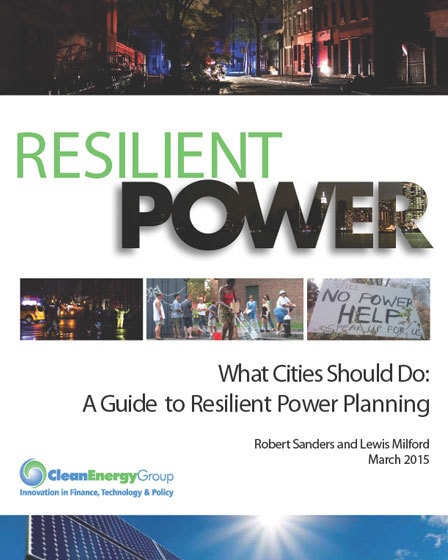March 3, 2015
Cities and Resilient Power: A Clean Energy Solution for Climate Adaptation
By Lewis Milford

Clean Energy Group’s report, What Cities Should Do: A Guide to Resilient Power Planning, describes a plan of action for cities to become more “power resilient” using new technologies like solar and battery storage, which can be more reliable than diesel generators to protect vulnerable populations from harm due to power outages caused by severe weather.
In addition, resilient power systems can provide power continuously as well as provide power protection when the grid goes down. Solar PV and energy storage (solar+storage) systems could also save money, generate revenue from ancillary services such as frequency regulation services and demand response, reduce peak load demand, and reduce reliance on fossil fuels.
Cities need to look at their critical facilities and decide how new, cleaner technologies can protect the elderly, the disabled, and the poor from the devastating effects of power outages. Clean Energy Group’s report includes planning guidelines for cities and towns that are preparing to deploy resilient power systems to lessen the impacts of severe weather events and other events that can disable the electric grid.
The report also describes how emerging technologies like solar+storage can provide cleaner and more reliable solutions available to protect community members in affordable housing, assisted living, schools, and emergency shelters.
In What Cities Should Do, Clean Energy Group says that cities should consider the following recommendations to implement a resilient power plan:
- Assign a person or group in charge of the problem and implementing the plan
- Identify the top list of critical facilities in need of power protection
- Assess the critical power loads in each priority critical building/facility that need to be covered during a power outage
- Determine the costs and technology options for each resilient power system, by looking at newer, clean energy options like solar+storage
- Find an energy storage developer to design and build the project
- Identify financing options to get the job done at least cost, including those that monetize new grid ancillary services that could significantly reduce the upfront capital costs of these projects.
Cities need better strategies and investment plans to protect their populations from power outages in severe weather events, and they can rely on new technologies like solar+storage to do so. What Cities Should Do is a valuable resource for state and city planners, project developers, building owners, and facility managers who would like to learn more about the vital role of resilient power in a city’s climate adaptation plan.
Clean Energy Group has also released a companion report, Solar+Storage 101: An Introductory Guide to Resilient Power Systems, available here.














